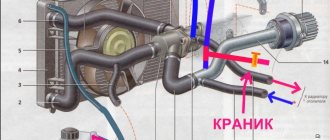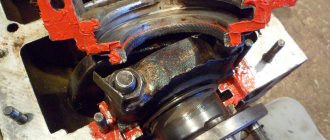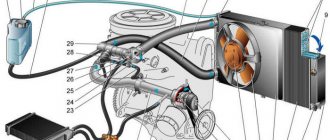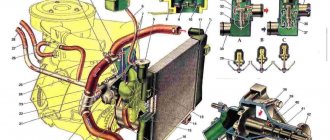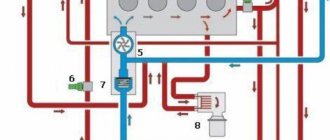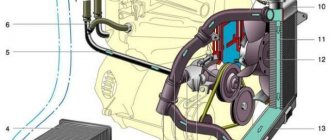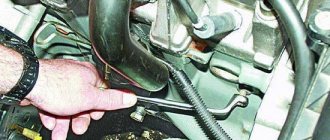The Lada Kalina car is a fairly popular model, which has recently been actively in demand in the secondary market. In general, the car is quite simple and reliable, but there are some “childhood diseases”.
In the case of this car, it was the Kalina stove and the cooling system as a whole that turned out to be not entirely finalized. For this reason, owners are often faced with the fact that the engine is warmed up, but the stove on Kalina blows cold or slightly warm air, the engine itself overheats, antifreeze leaks appear, etc.
Moreover, such problems can be eliminated at minimal cost. The main thing is to take into account the nuances and scope of modernization work in advance. Next, we will look at what to do if the Kalina heater does not work well, the engine cooling system (ECS) becomes airy, overheating occurs, etc.
The cooling system (VAZ Lada Kalina) includes a number of functional elements:
- Engine cooling radiator. This unit is designed to reduce the temperature of heated antifreeze using a cold air flow.
- Radiator fan. This part performs the function of increasing the intensity of coolant cooling () in the system.
- Heater radiator. This is essentially a source of warm air for the car interior.
- Expansion tank. Since coolant tends to expand and contract with constant temperature fluctuations, this container serves to compensate for the volume of antifreeze in the system.
- Centrifugal pump or “pump”. This element carries out forced circulation of coolant through the channels of the vehicle system.
- Thermostat. This small, seemingly primitive part, performs a very important function: it regulates the required amount of antifreeze passing through the engine cooling radiator. Thanks to the thermostat, the most optimal temperature regime in the system is ensured.
- Coolant temperature sensor. This is one of the control elements of the ODS.
The engine cooling system diagram (Kalina 2117) is shown in the photo below:
What's the result?
Taking into account the above information, it becomes clear that if the stove does not heat or the engine overheats, the Kalina thermostat is not always the cause of the problems. Of course, when such symptoms appear on Kalina, the thermostat and coolant level should be checked first. However, it often happens that the thermostat is working, as well as the antifreeze level is normal.
In this case, the cause is precisely air locks. Moreover, attempts to “expel” air from the engine cooling system using standard methods often do not yield results. For this reason, improvements to the system itself are necessary to eliminate the possibility of an air lock forming in the future.
Finally, we note that the only disadvantage of the method of improving the Kalina SOD discussed above is that the engine may take longer to warm up. Moreover, against the background of the problems that arise when the standard system is aired (overheating of the internal combustion engine, cold stove, etc.), such a drawback practically does not manifest itself at all, even in the cold season.
Sources
- https://xn—-8sbabr6ahc3e.xn--p1ai/kalina-remont/192-ustroistvo-sod-kalina.html
- https://avtodvigateli.com/detali/sistema-oxlazhdeniya-kalina-8-klapanov.html
- https://expertVAZ.ru/lada-kalina/zamena-zhidkosti-sisteme-oxlazhdeniya.html
- https://carfrance.ru/polnaya-sxema-sistemy-oxlazhdeniya-dvigatelya-lada-kalina/
- https://FB.ru/article/139510/kalina-sistema-ohlajdeniya-neispravnosti-i-usovershenstvovaniya
- https://remam.ru/vozdsys/dorabotka-sistemy-ohlazhdeniya-lada-kalina.html
- https://Vaz-Lada-Granta.com/kalina/motor-i-korobka/sistema-ohlazhdeniya.html
- https://ladaautos.ru/lada-kalina/prichiny-zavozdushivaniya-sistemy-oxlazhdeniya-lady-kalina-i-dorabotka.html
- https://KrutiMotor.ru/sistema-ohlazhdeniya-kalina-dorabotka-sistemy-ohlazhdeniya-lada-kalina/
Principle of operation
The operating algorithm of this system consists in the close interaction of various sensors, parts and elements, including devices that measure oil temperature, outside temperature and many other factors. Taking into account all these points, on the VAZ Kalina the cooling system automatically sets the optimal switching conditions and operating time of all structural elements, thereby ensuring effective engine cooling.
It should also be noted that depending on the temperature, the liquid can pass through a small or large circle. In the first case, the antifreeze passes through all the channels of the system, bypassing the radiator. The thermostat is in the closed position during such circulation. When the engine temperature increases, this part gradually opens, and the antifreeze begins to “run” in a large circle, getting into the radiator. The latter is cooled by a counter flow of air, and if the SOD is not enough, it will send a signal to the fan, which will force cold air onto the cells.
After cooling, the coolant flows back to the small circle. Then, depending on the engine temperature, the system automatically circulates antifreeze either in a large or small circle, maintaining the optimal operating temperature of the internal combustion engine (95-105 degrees Celsius).
Symptoms of problems
There are a number of symptoms that indicate a malfunction of the cooling system; if at least one of them is detected, it is worth taking corrective action.
- When the engine is not started and has cooled down (more than 8 hours of inactivity), a residual pressure remains in the cooling lines (this can be understood when the rubber pipes are pressed, they will be hard).
- The release of coolant when the engine is running can be either a small amount or a significant column of steam.
- Coolant leakage from lines or radiators is accompanied by a decrease in the coolant level in the tank.
- When the engine is fully warmed up, cold air blows from the deflectors coming from the cabin heater. The effect may disappear when the crankshaft speed increases.
And if with the first three points everything is more or less clear, then with the last it’s not so simple. You can change radiators, thermostats and coolant as much as you like, but you still won’t achieve a positive result. The problem is the formation of an air lock that cannot be seen. The air in the lines prevents the normal removal of heat from highly heated parts, which can lead to serious damage to the power plant.
The most common causes of coolant leakage from the system are:
- Old clamps on the pipes.
- An old heating radiator or a broken cooling radiator. In the first case, the situation will only be saved by a complete replacement of the device, but in the second, it is quite possible to get by with repairs (soldering the holes).
The next step is to check the coolant circulation in the engine cooling system. To do this, open the cap of the expansion tank and watch how a stream of antifreeze enters it. If the result is unsatisfactory, you need to either change the pump or clean the SOD system (this can be done using special cleaning products).
A little theory
The Kalina engine cooling system of 8 valves provides cooling of the power unit. Thus, the operating temperature of the motor is 87-103 degrees Celsius.
If this indicator rises, then the engine may overheat, and accordingly the motorist will face quite unpleasant consequences, such as head deflection or, even worse, water hammer.
The power unit may overheat if one of the cooling elements fails. First, there will be a mild stage, during which the engine will simply boil. But there can also be serious consequences, such as deflection and deformation of the cylinder head. At this stage, the situation can be corrected by ordinary grinding of the surface of the block head.
If your car begins to overheat frequently, there may be several reasons for this:
- Thermostat. It is very simple to check its performance: on a warm engine, touch the lower and upper radiator hoses with your hand. If the latter turns out to be cold, and the lower one is barely warm, then, most likely, the thermostat is jammed, and the antifreeze circulates only in a small circle. In this case, the solution to the problem will be to install a new device in the car.
- Clogged radiator honeycombs. This is also one of the common causes of malfunctions in the cooling system. It occurs especially often in late May - early June, when annoying poplar fluff flies along the street. The solution to the problem is to clean the outer part of the radiator. This work often causes difficulties for car enthusiasts, but no other methods have yet been invented to solve clogged honeycombs. Therefore, everything is cleaned by hand.
- Faulty fan. If you notice that when the coolant heating level increases, this part does not turn on, you should check the temperature sensor, wiring and relay.
- Air in the cooling system. "Kalina", like any other car, is not immune to an airlock inside the SOD. And if in all previous cases the problem was solved very quickly, or at least clearly, then here car enthusiasts often have problems. Therefore, in order to fully explain the picture, below we will look at how such breakdowns are eliminated.
As you can see, malfunctions of the Kalina cooling system can be quite different. But in any case, overheating is not the best factor for the engine.
Main problems and solutions
The main malfunctions associated with the cooling system include two parts that most often fail: the thermostat and the water pump (checking its operation).
The first is characterized by jamming in a small circle, which leads to frequent turning on of the fan and possible overheating of the engine. In the second - wear of the pulley, as well as the shaft, which, when worn out, begin to leak fluid out.
Thus, drips from the pump may indicate that it is “on the verge” and needs to be replaced immediately. A sign of thermostat failure is frequent overheating and turning on of the fan. If such factors occur, the part must be replaced. If the fan, on the contrary, does not turn on, then there is a breakdown either in the relay or the fuse has blown.
Consequences of untimely replacement of ODS elements
The consequences of untimely replacement of cooling system components on a car can be:
- Overheating of the cylinder head , which will lead to gasket breakdown, as well as, more tragically, deformation and bending of the cylinder head. Such consequences will lead to grinding of the internal surface, as well as major repairs of the unit.
- At worst, coolant will enter the cylinders engine and it just knocks. In this case, the owner can get away with major repairs or replacement of the main power unit.
Measuring the deflection of the block head after the engine boils
These are the main consequences that you should be wary of, so diagnostics and repair of the cooling system must be carried out every 20,000 km.
Tuning
Many car enthusiasts install sports kits on Kalina to improve the performance of the cooling system. So, they can be ordered in stores or purchased at car markets. What differences do they have from the standard ODS system:
- An additional pump with an electric drive is installed.
- The sports thermostat is made of cermet, so its service life is much longer than the standard one.
- The sports lines of the cooling system are made from a special material, which also allows for additional cooling.
The basic cost of a sports cooling kit for Kalina is about 20,000 rubles.
“Lada Kalina” and an airlock: how to remove airlock?
The first step is to open the expansion tank cap. Next, start the engine and, periodically pressing the gas pedal, warm up the engine until the temperature gauge rises to the red scale. After turning on the fan, give it a little more gas and turn off the ignition. If the airlock cannot be eliminated in this way, you will have to move on to more radical measures.
How is this done? First, the plastic engine screen is removed (it can be removed with a simple upward movement). Next, use a screwdriver to loosen the clamp, and remove one of the two tubes from the throttle assembly heating fitting. Then the cap of the expansion tank is unscrewed. Cover the neck of the container with a clean rag. Next, you need to blow into the expansion tank until coolant flows out of the removed tube. If you are unable to break through the container, close the lid and put back the throttle assembly tube. Next, you need to warm up the engine again and turn off the ignition. After this, without removing the cap from the tank, remove the heating tube again and wait until antifreeze flows out of it under pressure.
Filling with new coolant Kalina
The installation of new pipes is complete. Now the most interesting part is that you need to fill in new antifreeze. Don't forget to tighten the bolts from the drain holes back. I use Felix Green G11. To avoid the occurrence of a large number of air pockets, before filling in the coolant, I removed one hose from the throttle heating - the highest point of the cooling system. During the process of filling the system, air could be heard escaping. Out of 10 kg of antifreeze, about 2 liters remain in the canister.
I filled it up to the MAX mark on the expansion tank and put the hose from the throttle back in place. Now you can try to start the engine and see what happens. Before this, of course, you need to put in place the ignition module and the air filter along with the mass air flow sensor and the adsorber valve.
After the first start, the engine heated up to 120 degrees, but the radiator remained cold. I waited about 10 minutes until the engine cooled down and SLOWLY unscrewed the cap from the expansion tank, releasing the pressure, and then unscrewed it completely. At that moment I heard a gurgling sound - excess air was coming out. Some fluid has leaked into the system. I added new fluid to the reservoir and started the engine again. This time everything worked as it should - the radiator warmed up, the fan turned on, the stove was heating, the temperature stayed around 90º.
Sources
- https://avtonomnaya-gazifikaciya.ru/kalina/sistema-ohlazhdeniya-1.html
- https://gil-service.ru/dvigatel/dorabotka-termostata-kalina.html
- https://krutigayki.ru/sistema-ohlazhdeniya-kalina-vse-o-tom-chto-delat-chtoby-dvs-avtomobilya-ne-peregrevalsya/
- https://na-vi.ru/sistema-ohlazdenia-kalina/
- https://TrueScooters.ru/vidy-dvigatelej/sistema-ohlazhdeniya-lada-kalina.html
- https://CdmService.ru/salon/ohlazhdenie-dvigatelya-lada-kalina.html
- https://Vaz-Lada-Granta.com/kalina/motor-i-korobka/sistema-ohlazhdeniya.html
- https://topdetal.ru/stati/boremsya_s_peregrevom_i_kholodnoy_pechkoy_na_kaline/
- https://autobryansk.info/sistema-ohlazhdenija-dvigatelja-kalina-8-klapanov.html
- https://vaz.today/sistema-ohlazhdeniya-kalina
[collapse]
How to improve SOD?
At the moment, there are several ways to improve ODS:
- Reworking the cooling system. “Kalina” in this case is equipped with a new 6-hole thermostat. This action will make maintaining the temperature of the antifreeze in the system more stable, and will also normalize the operation of the heating elements of the cabin.
- To reduce cooling system malfunctions, the Lada Kalina is equipped with a coolant filter.
- Installation of the stove faucet.
- Additional pump in the engine cooling system. It will not only prevent you from freezing in your car during winter cold, but will also force antifreeze to circulate faster through the channels, which will significantly reduce the risk of engine overheating.
So, we found out how the cooling system in the VAZ Kalina is designed, what problems can arise with it, and how to fix these problems.
| The engine cooling system (ECS) is one of the main systems of a car. Is cold air blowing from the stove or is the engine on the LADA Kalina overheating? Then the inspection should begin with this system. In this article you will find all the information on the operation of the Lada Kalina cooling system. |
So where should you start?
The first thing you need to do is check the antifreeze level in the system. To do this, open the hood and look at the expansion tank. Ideally, it should be filled to ½ of the total volume. If necessary, add coolant to this level.
If you find an antifreeze leak, then inspect the engine compartment of the car - there may be leaks here.
How to diagnose SOD?
We have already found out how the cooling system in the VAZ 2117 Kalina is arranged, now we will talk in more detail about how to find out its possible malfunctions.
Please note that if you doubt the proper operation of the cooling system, you do not have to take the car to a service station and order diagnostics - you can find out the reasons yourself.
Design features of the LADA Kalina engine cooling system
The LADA Kalina engine cooling system is liquid, closed type, with forced circulation. Consists of an engine cooling jacket, a radiator with an electric fan, a thermostat, a pump, an expansion tank and connecting hoses.
Design of the LADA Kalina cooling system
Cooling system : 1 — expansion tank; 2 — radiator outlet hose; 3 - inlet hose; 4 - radiator; 5 — steam exhaust hose; b — radiator supply hose; 7 — electric fan; 8 — electric fan casing; 9 — coolant temperature sensor; 10 — coolant temperature indicator sensor; 11 — throttle assembly; 12 — bracket for the coolant pump pipe; 13 — coolant pump; 14 — coolant pump pipe; 15 — heater radiator supply hose; 16 — heater radiator outlet hose; 17 — exhaust pipe; 18 — coolant pump pipe hose; 19 — thermostat housing
| Expansion tank . Coolant is poured into the system through the expansion tank. It is made of translucent polyethylene, which allows you to visually monitor the liquid level. To do this, the marks “MAX” and “MIN” are marked on the wall of the tank. In the upper part of the tank there is a pipe for connecting to the radiator steam exhaust hose, in the lower part there is a pipe for connecting to the inlet hose. |
| Expansion tank cap with valves . The tightness of the system is ensured by the inlet and outlet valves in the expansion tank cap. The exhaust valve maintains increased (compared to atmospheric) pressure in the system on a hot engine (due to this, the boiling point of the liquid becomes higher, steam losses are reduced). It begins to open at a pressure of at least 1.1 bar. The intake valve opens when the pressure drops to system relative to atmospheric pressure by 0.03-0.13 bar (on a cooling engine). |
| The coolant pump is a vane, centrifugal type, driven from the crankshaft pulley by a timing belt. The pump housing is aluminum. The roller rotates in a double-row bearing. The bearing is lubricated for its entire service life. The outer ring of the bearing is locked with a screw. A toothed pulley is pressed onto the front end of the roller, and an impeller is pressed onto the rear end. A thrust ring made of a graphite-containing composition is pressed to the end of the impeller, behind which there is an oil seal. The pump housing has a control hole to detect fluid leakage when the pump fails. It is recommended to replace the pump as an assembly. The redistribution of liquid flows is controlled by a thermostat. |
The cooling system consists of two so-called circulation circles:
- The movement of liquid through the cooling jacket and radiator forms a large circulation circle.
- The movement of liquid through the engine cooling jacket, bypassing the radiator, is a small circle of circulation.
The cooling system also includes a heater radiator and a throttle body heating unit. Liquid circulates through them constantly and does not depend on the position of the thermostat valves.
| Thermostat . It has a solid temperature-sensitive element and two valves that redistribute the flow of coolant. On a cold engine, the main thermostat valve blocks the flow of fluid from the radiator and the fluid circulates only in a small circle, bypassing the radiator. At a temperature of (85±2) °C, the thermostat valves begin to move, allowing liquid flow into the radiator and closing the bypass channel. At a temperature of about (100±2) °C, the main valve opens completely and the bypass valve closes. Almost all the fluid circulates in a large circle through the engine radiator. |
| Coolant temperature sensor . To monitor the coolant temperature, a sensor is screwed into the engine cylinder head, connected to the temperature indicator in the instrument cluster. In the outlet pipe, next to the thermostat housing, there is a coolant temperature sensor that provides information to the controller. |
The heater radiator is built into the engine cooling system and is designed to heat the passenger compartment by circulating hot coolant through it.
| The radiator consists of two vertical plastic tanks (the left one with a baffle) and two horizontal rows of round aluminum tubes passing through the cooling plates. The tubes are connected to the tanks through a rubber gasket. The liquid is supplied through the upper pipe and discharged through the lower. Next to the inlet pipe there is a thin pipe for the steam removal hose. The radiator has a casing with an electric fan. There is a drain plug at the bottom of the right tank. |
The fan maintains the thermal operating mode of the engine and is switched on via a relay based on a signal from the controller.
Problems and methods for solving them
There are few actual reasons for failures and deviations in the functioning of the cooling system in LADA Kalina. Liquid leaks are the most common. They can arise from loose clamps on the pipes, through the gasket or seal of the pump, a broken radiator (also in the heating circuit), etc. Copper radiators used to be subject to repair, but it is unlikely that it will be possible to successfully restore a modern aluminum product. The clamps can be tightened, and if it doesn’t help, they can be replaced, fortunately this is a cheap idea. The radiator is much more expensive, so replacement may be burdensome, but there is no other way.
Sometimes the engine cooling system can become clogged. This will require cleaning followed by a complete fluid replacement.
We will also consider other problems that arise in the cooling circuit of the Lada Kalina.
- Thermostat. An effective diagnostic measure would be to manually touch the pipes connected to the radiator. If the lower radiator hose does not warm up on a warm engine, then we can safely state that the thermostat has failed. The valve stopped opening, preventing the liquid from circulating in a large circle. The only way out is to change the part.
- The radiator honeycombs are clogged. Here you also need to resort to cleaning. In spring and summer, debris clogs the honeycombs, making the radiator ineffective in terms of cooling.
- The fan has failed. The first step is to check the integrity of the wiring and the serviceability of the relay in the Lada Kalina with an 8 or 16 valve engine. Most breakdowns point to these components.
- Airing of the system, the so-called air lock. Often air can get inside the circuit, forming plugs. Airing of the system can often be observed after replacing antifreeze. To combat this phenomenon, open the reservoir cap and raise the engine speed (accelerate). If the traffic jam cannot be removed, we try to raise it in front of the car (as high as possible) and continue to practice with the accelerator. Blowing out the tank until liquid appears from the fitting also helps.
How to troubleshoot your cooling system yourself
If you notice that a stream of cold air is entering the cabin, you should not delay repairs, especially if the autumn-winter period is upon us.
Fixing improper cooling can be done in several ways. Car enthusiasts recommend following step-by-step instructions on the forums:
- Remove the hose from the part responsible for heating the throttle assembly.
- Open the expansion tank cap and place a clean, dry cloth on top of the neck.
- Blow into the tank.
- Monitor the progress of the antifreeze. As soon as the coolant appears on the horizon, quickly return the hose to its original place and tighten tightly with a clamp.
Why might this method be dangerous? Coolant is a toxic solution and must be handled with extreme care, so to prevent the substance from spilling, it is advisable to enlist the help of a friend who will help you quickly install the hose. In addition, antifreeze is hot and can burn your hand.
Another option for combating the airing of the cooling system in the Lada Kalina from folk craftsmen, it is more reliable:
- Wait until the engine has completely cooled down. Remove the hose from the expansion tank. It is mounted close to the rest of the components of the Lada Kalina cooling system.
- Pour liquid into the antifreeze reservoir to the maximum possible level and screw the cap tightly.
- Place the hose in an empty container up to 5 l. Place a hose coming from the air pump unit onto the tank nozzle; the latter is intended for inflating Lada Kalina tires.
- Use a pump to pump up the pressure in the tank, so that the coolant will move freely into the prepared canister.
- Do not take your eyes off the reservoir, otherwise the liquid may overflow. If, on the contrary, it is not enough, antifreeze should be added to the required value.
- When the liquid is completely added, put all existing connections back in their original places.
An important nuance - if clogging of the cooling system with a plug on the Lada Kalina occurs with enviable regularity, this means that the cooling system is far from ideal tightness. Therefore, check the connections and fit of the components to each other.
How to modify the cooling system of the Lada Kalina
Traditionally, modification of the cooling system on the Lada Kalina involves the installation of a new thermostat with 6 recesses, a filter through which antifreeze passes, and a faucet for the furnace mechanism. Service station workers also recommend installing another pump. This amount of work requires repair skills and knowledge. The average driver does not have them.
Therefore, craftsmen came up with another way to improve the cooling system. Follow the step by step instructions:
- The cooling system should be looped with a hose that was previously used to warm up the throttle assembly.
- Take an extra hose, a tee and enough clamps, and then install a connection with a smaller diameter. This will help ventilate the cooling system and bring it back to life.
- It is preferable to place the air vent closer to the thermostat; a prepared tee will help with this. It should be cut into the supply hose to the radiator unit.
- Now start processing the second end of the air outlet component, attach it to the steam outlet passing near the RB fitting.
The proposed modification to the cooling system of the Lada Kalina will make it possible to maintain the temperature when moving the car at a constant level of 90 to 95 degrees. At the start, the stove warms up to 50 degrees. How expensive is this method of improving a cooling system prone to air pollution? When purchasing the missing coolant, tees and clamps, 1 m of hose, 600 rubles were spent. Those who have already tried the modification note a noticeable decrease in engine temperature, but before that it heated up to 100 degrees, and cold air flowed into the cabin from the furnace mechanism.
Important points of improvement
Coolant is considered a toxic substance that adversely affects human health. Auto mechanics recommend draining antifreeze with caution. When carrying out this procedure, you need to remember safety precautions and use rubber gloves. The antifreeze is drained when the engine is cold. Then the tube is put on the fitting, the clamps are tightened. Air masses have been successfully removed from the system under consideration.
Kalina's SOD needs improvement. Its modification involves the installation of a new 6-hole thermostat. This unit will maintain a stable fluid temperature, normalizing the operation of the interior heating devices.
Modification of the cooling system involves installing a coolant filter or a heater tap. To ensure that antifreeze passes through the channels faster and the risk of overheating is minimal, you will need to install an additional pump. You can tune the Kalina SOD yourself using the engine cooling system diagram.
LADA Kalina engine cooling system diagram
Cooling system : 1 — coolant drain hose from the heater radiator; 2 — hose for supplying coolant to the heater radiator; 3 — coolant pump supply pipe hose; 4 — expansion tank hose; 5 - expansion tank; 6 — steam exhaust hose of the engine radiator; 7 — thermostat; 8 — hose for supplying fluid to the throttle assembly; 9 — hose for supplying fluid to the engine radiator; 10 hose for draining fluid from the engine radiator; 11 — engine radiator; 12 radiator drain plug; 13 electric radiator fan; 14 coolant pump; 15 supply pipe of the coolant pump; 16 coolant drain hose from the throttle body
Self-tuning
Engine cooling system for VAZ-2110 and VAZ 2111
thermostat failure. To check its performance, visually inspect the radiator pipes. If the top is cold and the bottom is warm, then the thermostat is stuck. In this case, you will need to install a new device; the honeycombs are clogged. In this case, the engine overheats in spring or summer. It is recommended to clean the radiator (from the outside); fan failure. The device does not start due to high coolant heating. It is recommended to check the functionality of the relay and wiring; air in the system. In this case, open the expansion tank. After starting the engine, periodically press the gas (until the red mark is reached). If the fan starts, then they “add up the gas” by first turning off the ignition. If the breakdown is not repaired, then the power unit screen is dismantled. First raise the motor and lower the clamp. One pipe is dismantled. The lid is removed and the container is broken through. The tube and cap are installed in place. The engine warms up and the ignition turns off. Then remove the heating tube
Since antifreeze is a toxic substance, it is recommended to drain it carefully (following safety precautions). The engine must be cold. The tube is put on the fitting, the air is removed.
The tube is put on the fitting, the air is removed.
If the engine gets hot, the Lada Kalina SOD will be upgraded. Refinement of the system consists of installing a thermostat with 6 holes. The device is designed to maintain a stable fluid temperature and normalize the operation of interior heating devices. If necessary, install a coolant filter or heater tap. To quickly pass antifreeze through the channel (with minimal risk of overheating), an additional pump is installed.
The system under consideration is suitable for the C/O and N/O stove on the VAZ 2110. In the first case, it will be necessary to throttle the output from the SOD. In this case, the stove will only work at high speeds. In order for hot air to flow from the heating unit, press the gas pedal. If you reduce the output from the C/O stove, then the pressure in the remote control will rise. To do this, use a throttle or ball valve. Before installing Kalina SOD in a VAZ, it is recommended to consult with specialists.
IF WE WERE CONDUCTING THE RECALL CAMPAIGN
Cooling system diagram for VAZ-2112 16 valves injector
Back in the February issue (pp. 112–114), when we were first able to look at “Grant,” as they say, under a magnifying glass, we talked about much more significant shortcomings. For example, at the entrance to the engine compartment there is a plastic casing dangling - protecting the fuel line pipes and adsorber. The lower radiator hose, which rubs against adjacent parts, clearly lacks fastenings. Mediocre clamps on the engine ventilation pipes do not provide tight connections: after a year of operation, the engine will be covered with an oil coating. And this is only part of the shortcomings. We will definitely tell you about the rest in the near future - look forward to regular reports on the editorial “Grant”.
Returning to the recall campaign: it is a pity that the forces and means were used ineffectively. It is possible that eliminating the shortcomings we have identified would cost the manufacturer more, but in the future it will pay off faster. After all, it is serious investments in reliability that AVTOVAZ now lacks in order to build a high-quality car.



